<<back
Lesson Plan SINGAPORE
G. Singapore
G.1. Water and environmentally sustainable development
G.1.1. Overview and Background Information
- The proposed lesson of 35 mins duration is on the sub-topics of distribution of water on earth and the hydrological (water) cycle in the topic of Rivers in Sec 1 Geography. It is part of the theme of the Physical Environment.
- Learners would already have some knowledge of concepts of evaporation, transpiration and condensation from their science lessons in primary school.
- The proposed lesson is on the strand of water, environmentally sustainability development.
- Teachers’ notes: This lesson may be reinforced with a field trip to the Newater Centre or any other waterworks in Singapore.
G.1.2. The Lesson Plan
Subject Matter area |
Geography |
Time duration |
Topic |
Hydrological (water) cycles |
|
Grade |
7 |
|
Specific concepts covered in the lesson |
Evaporation, transpiration, condensation, precipitation, runoff, hydrological cycle |
|
Human values addressed |
Right conduct (responsibility, resourcefulness) |
|
Lesson objectives |
At the end of the lesson, learners will be able to:
- describe the processes in the hydrological cycle
- apply knowledge of the hydrological cycle to suggest some solutions to the water shortage problem in Singapore.
- demonstrate resourcefulness and social responsibility
|
|
Materials needed |
- A bottle containing salt water (very salty) and 8 empty cups
- Teacher’s Resource A
- A geography textbook – relevant chapter on the distribution of water on earth
- Worksheet 1: How can we get freshwater?
- 8 sets of the following: flasks of hot water (near to boiling point), salt, spoon, ice cubes, plastic bag, 2 jam jars/glasses, wire mesh, large bowl
- Worksheet 2: Creative solution to water constraint in Singapore
- Handout 1: Rubric
|
|
Teaching-Learning Steps: |
35 mins |
Introductory or Motivational activities |
- Divide the class into 8 groups.
- Fill 8 empty cups with salt water.
- Give each group a cup of salt water and get learners to taste and guess its content.
- Elicit responses from learners about the content of the cup.
- Tell learners that the water contains salt.
- Pose the following questions and elicit responses.
- Can we live by drinking this water everyday?
- What will happen to us if we continue to drink this water everyday?
- What type of water is drinkable?
|
5 mins |
Lesson proper

|
Exposition & Investigative Task
- Introduce the topic to the class: Distribution of water on earth and the hydrological cycle
- Write down the following focus question on the board:
- Will the world run out of water supply?
- How can we increase the water supply in Singapore by using the concept of the hydrological cycle?
- Pose the following questions and elicit responses.
- What are the processes that make up the hydrological cycle?
- How is the hydrological cycle formed?
- How can we increase the water supply in Singapore by using the concept of the hydrological cycle?
- Show Teacher’s Resource A (See Attachment 6.G.1.1) and highlight the following main points:
- 70% of the earth’s surface is covered with water;
- 97% of the earth’s water consists of ocean saltwater;
- remaining 3% is freshwater but most of which (2%) are frozen; and
- only 1% of the water that comes from streams, rivers and lakes can be used for drinking, farming and industry.
- Instruct learners that they are to conduct an experiment and pose the following question: Will salt water always remain as salt water after you have heated it up and allow the water vapour to cool?
- Distribute Worksheet 1 (See Attachment 6.G.1.2) to each group and get learners to complete the investigative task.
- Get groups to present their observations in Worksheet 1 and elicit responses from the class after the activity. Provide correct answers to the wrong observation and interpretation.
- Use Worksheet 1 (Q7) to explain the hydrological cycle by teaching the following main points:
- Water evaporates from the seas, oceans, rivers, lakes and land and transpires from vegetation;
In the atmosphere, water vapour cools and condenses to form clouds which precipitate rain (or snow). The rainwater falls onto the ground as runoff, seeps into the soil as underground water and flows into rivers/lakes/seas/oceans. |
25 mins |
Closure |
Summaries the processes in the hydrological cycle and human role and responsibility when modifying the hydrological cycle. |
5 mins. |
Assessment / Evaluation |
- Distribute Worksheet 2 and alert learners to the focus question: How can we increase the water supply in Singapore by using the concept of the hydrological cycle?
- Explain the rubric in Handout 1 and remind learners to bear in mind the rubrics when completing Worksheet 2. Ask learners to assess their own performance using Handout 1.
- Collect Worksheet 2 for teacher-assessment.
|
|
Attachment 6.G.1.1
Teacher’s Resource A
 
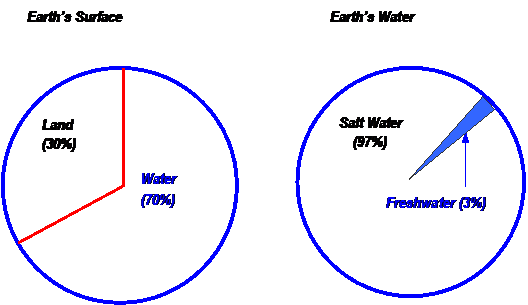
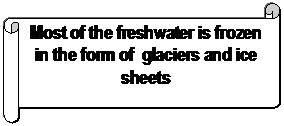

Attachment 6.G.1.2
Worksheet 1
Name: ______________________ ( )
Class: ___________ Date: ____________
How can we get freshwater?
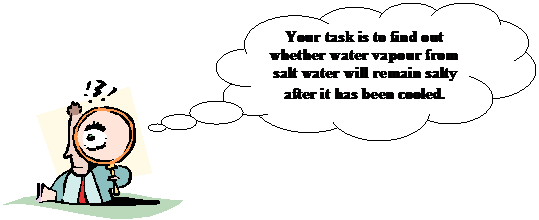

B. Record your observations based on the following questions:
1 What process has taken place to form the steam?
This means that water has been ________________________________
2 By adding salt to the water, what have you created that best represents a physical feature (i.e. a water body) found on the Earth’s surface?
______________________________________________________________
3a What can you find on the surface of the plastic cover?
______________________________________________________________
3b Based on your answer in 3a, what process led to the formation of the substance on the surface of the plastic cover?
______________________________________________________________
______________________________________________________________
3c Using your knowledge learned earlier in the topic of weather and climate, what does the plastic cover best represent in the real world?
______________________________________________________________
______________________________________________________________
4a Taste the substance found on the surface of the plastic cover. Is it salty? What is it?
______________________________________________________________
______________________________________________________________
4b Based on your answer in 4a, explain how is this substance formed?
______________________________________________________________
______________________________________________________________
5a. Observe the substance found on the base of the jam jar in the bowl. Where does the substance come from? Is it salty? What is it?
______________________________________________________________
______________________________________________________________
5b. Based on your observation in 5a, state the process that best describe the formation of the substance on the base of the jam jar.
______________________________________________________________
______________________________________________________________
6. What have I learned from this activity?
______________________________________________________________
______________________________________________________________
7. In the boxes provided in Figure 1, write down the processes in the water cycle.
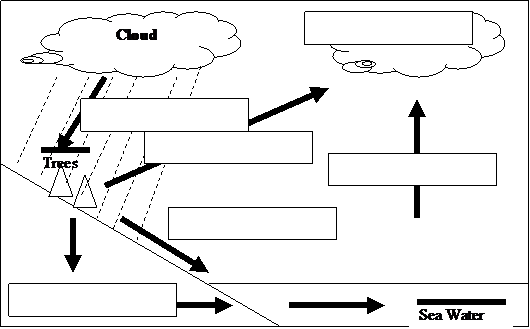
Figure 1
Worksheet 1: Suggested Answers
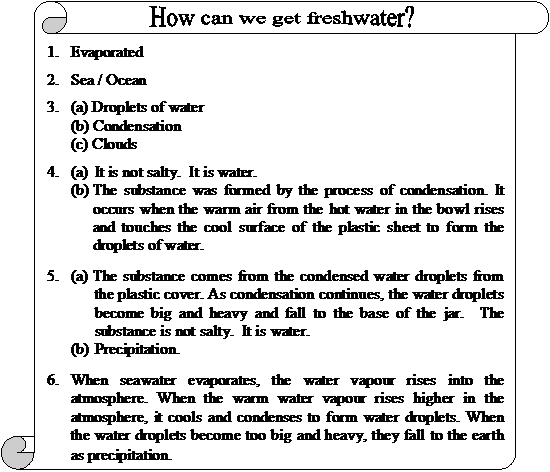
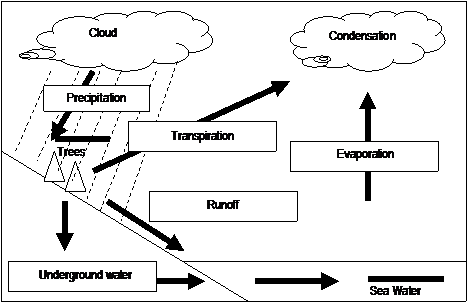
Worksheet 2
Name: ______________________ ( )
Class: ___________ Date: ____________
Creative Solution to Water Constraint in Singapore

You have been appointed by the Singapore government to look into ways to increase the supply of water in Singapore. Based on your understanding of the water cycle, identify one process within the water cycle which could be used to increase water supply in Singapore and explain how this can be done.
1. The hydrological cycle process that I would like to select is ___________________
2. Explain how the selected process in the hydrological cycle can be used to increase the supply of water in Singapore?
_______________________________________________________________
_______________________________________________________________
_______________________________________________________________
Handout 1
Name: ______________________ ( )
Class: ___________ Date: ____________

Performance
Level
Criterion |
Just Starting
1
|
Getting There
 2 2 |
Got It!
3
|
Apply knowledge of the hydrological cycle to solve a problem in an unfamiliar setting |
I am able to apply limited knowledge of the hydrological cycle to solve a problem in unfamiliar setting. |
I am able to apply some knowledge of the hydrological cycle to solve a problem in unfamiliar setting. |
I am able to apply adequate knowledge of the hydrological cycle to solve a problem in unfamiliar setting. |
- My assessment of my performance level
|
|
|
|
- Teacher’s assessment of my performance level
|
|
|
|
G.2. Water, social equity, and human dignity
G.2.1. Overview and Background Information
- The proposed lesson of 35 mins duration is on the sub-topic of water uses in the topic of Water Resources in Sec 2 Geography. It is part of the theme of Managing the Changing Environment.
- Learners would already have some knowledge of general uses of water (e.g. water for irrigation, hydro-electric power and transport).
- The proposed lesson is on the strand of water for health, sanitation and recreation as well as the strand of water, environmentally sustainability development.
- Teachers’ notes: This lesson is the first lesson on the topic of water resources for Sec 2 learners. It may be conducted before or after an assembly talk on Water for All – Conserve, Value, Enjoy by the Public Utilities Board of Singapore.
G.2.2. The Lesson Plan
Subject Matter area |
Geography |
Time duration |
Topic |
Uses of water in Singapore |
|
Grade |
8 |
|
Specific concepts covered in the lesson |
Scarce resource, domestic and non-domestic usage, conservation |
|
Human values addressed |
Right conduct (responsibility) |
|
Lesson objectives |
At the end of the lesson, learners will be able to:
- describe the uses of water in Singapore.
- explain why water is an important resource in Singapore
- adopt good water saving habits
|
|
Materials needed |
- A glass of water
- Worksheet 1: Water, Me and My Country
- Pencils
- A geography textbook – relevant chapter on water supply in Singapore
- Worksheet 2: Help save
|
|
Teaching-Learning Steps: |
35 mins |
Introductory or Motivational activities |
- Show learners a glass of water and ask ‘Is a glass of water enough for your day’s needs?’
- Follow up with the following questions:
- Why is water important to life on earth?
- How do people in the world use water?
|
5 mins |
Lesson proper
|
Worksheet 1 – Part A (10 mins)
- Based on some answers provided, explain the term domestic and non-domestic usage of water.
- Get the learners into groups. Give each group a copy of Worksheet 1 and a pencil. Ask learners to take turns to write the domestic and non-domestic uses of water in Singapore on Worksheet 1. They are to pass the worksheet and pencil around in a clockwise direction.
- Elicit responses from learners.
- Highlight the following main points for Part A of Worksheet 1:
- Consumption of water is on the rise in Singapore
- Uses of water may be categorized into domestic and non-domestic uses
Worksheet 1 – Part B (15 mins)
- Next ask learners to read their Geography textbooks and discuss where Singapore’s water supply comes from and why it is important to manage water supply well.
- Get learners to record their discussion points on Part B of Worksheet 1.
- Highlight the following main points for Part B of Worksheet 1:
- Singapore is not self-sufficient in water even though water is collected from local reservoirs and storm water collection centres. About 50% of Singapore’s water supply comes from Johor, Peninsular Malaysia.
- Water is precious and limited in supply in Singapore. It is therefore important to conserve water.
With proper management of our water resources, we can have enough water for domestic and non-domestic uses for the present and for generations to come. |
25 mins |
Closure |
Summarize the main domestic and non-domestic uses of water and remind learners of the need to conserve water. |
5 mins. |
Assessment / Evaluation |
Assignment (Home)
- Ask learners to complete Worksheet 2 at home. They can refer to their textbooks and the PUB website at http://www.pub.gov.sg. They are to reflect on the measures that they can take to conserve water at a) home and in b) school and c) community. They are to submit Worksheet 2 for teacher assessment. Learners are also asked to surf the web and read up on the Marina Barrage, which will become Singapore’s 15th reservoir and first
- reservoir right in the heart of the city. Besides boosting water supply, it will also control flooding and help create a new lifestyle attraction.
|
|
Attachment 6.G.2.1
Worksheet 1: Water, Me and My Country
Name: ______________________ ( )
Class: ___________ Date: ____________

Part B: Sources of Water in Singapore
Write down the sources of water in Singapore in the water droplet provided below.

Why is it important to manage our water supply well?

Worksheet 2
Name: __________________________ ( )
Class: ______________ Date: ______________

In the boxes provided below the pictures, write a few sentences on how to save water.
My reflection on ways to conserve water
My reflection on actions/measures which I can take to conserve water
a. at home
_______________________________________________________
_______________________________________________________
_______________________________________________________
_______________________________________________________
b. in school
_______________________________________________________
_______________________________________________________
_______________________________________________________
_______________________________________________________
c. in the country
_______________________________________________________
_______________________________________________________
_______________________________________________________
_______________________________________________________
G.3. Water for health, sanitation and recreation
G.3.1. Overview and Background Information
- The proposed lesson of 35 mins duration is on the sub-topic of Case Study of Water Supply in Singapore in the topic of Water Resources in Sec 2 Geography. It is part of the theme of Managing the Changing Environment.
- Learners would have already have knowledge of weather and climate, the hydrological cycle and uses of water.
- The proposed lesson is on the strand of water, environmentally sustainability development.
- Teachers’ notes: Distribute the two worksheets to all learners before this lesson. Ask certain groups of learners to do research on the water supply and demand condition in Singapore. Learners are to bring the two worksheets and relevant research materials and illustrations to class for the lesson. This lesson is preferably conducted after a water rationing exercise in school.
G.3.2. The Lesson Plan
Subject Matter area
|
Geography |
Time duration |
Topic |
Case Study of Water Supply in Singapore |
|
Grade |
8 |
|
Specific concepts covered in the lesson |
Scarce resource, water constraint, technology |
|
Human values addressed |
Right conduct (responsibility, resourcefulness) |
|
Lesson objectives |
At the end of the lesson, learners will be able to:
- describe the constraint of water supply confronting Singapore
- appreciate water as a strategic and scarce resource in Singapore
|
|
Materials needed |
- Worksheet 1: Water Situation in Singapore
- Worksheet 2: Case Study of Water Rationing in 1963
- Handout 1: Beginning of the longest water rationing
|
|
Teaching-Learning Steps: |
35 mins |
Introductory or Motivational activities |
Recapitulate the possible solutions to water shortage in Singapore proposed by learners in the previous lesson. |
5 mins |
Lesson proper
|
- Ask learners to get into groups and ask one of the groups assigned to do research on water situation in Singapore to explain the water situation in terms of human factors like growing population, urbanization and industrialization and physical factors like limited land and small catchment area.
- Stress that water is a scarce resource though Singapore has an equatorial climate characterized by high temperatures and high annual rainfall.
- Invite learners to share their experience about the water rationing exercise in school or their feelings about the water rationing exercise in Singapore in 1963 described in Handout 1. Elicit from learners that water rationing is disruptive and brings about a lot of inconvenience. To prevent such situation in the future, water conservation should be taken seriously because water shortage would have dire consequences on our economy and daily life.
|
15 mins |
Closure |
Get learners to appreciate the need to allocate water through rationing during the water shortage in 1963. Inform learners that the water rationing exercise in 1963 serves to remind Singaporeans that water supply is limited but there is high demand for water. Stress to learners the need to conserve water. |
5 mins. |
Assessment / Evaluation |
Assignment (Home)
- Get all learners to complete Worksheets 1 and 2 and submit to teacher for marking.
|
10 mins. |
Attachment 6.G.3.1
Handout 1
BEGINNING OF THE LONGEST WATER RATIONING
Introduction
The ease by which we can obtain clean, piped potable water in Singapore at any time of the day masked the fact that water is a precious and scarce commodity. The public do not often remember that Singapore has already set aside 41% of land in Singapore for water catchment purposes; yet, we still have to import water from Malaysia under two water agreements which expire in 2011 and 2061. To remind Singaporeans of the need to conserve water, many publicity campaigns have been launched. In late 1997, water rates and water taxes were also increased to reflect its scarcity value. Our strategic vulnerability in water was brought home in Apr 1963 when Singaporeans underwent the longest period of water rationing in history.
Water Rationing in 1963 and 1964
Water rationing was necessitated by the severe drought which affected Johor and Singapore from early 1963. Water stocks were down to dangerously low levels at the Tebrau waterworks in Johor, and the MacRitchie, Seletar and Pierce reservoirs. The rainfall for Mar and Apr 1963 was in fact a quarter of the average rainfall for the two months, the lowest in ten years.
On the other hand, the hot and dry weather encouraged Singaporeans to use more water to cool themselves. There was also heavy demand on our water sources as more factories were set up in Jurong as part of our drive to industrialize. In addition, water was needed by the expanding population who increasingly lived in HDB flats with piped water.
On the afternoon of 23 Apr 1963, water rationing began. Singapore was divided into seven zones. Each zone is supposed to get no water six hours a day four times a week either from 8 a.m. to 2 p.m. or from 2 p.m. to 8 p.m. However, despite the water rationing and the appeal for the voluntary reduction of water usage, the amount of water saved proved inadequate as the drought became more serious and the water stocks fell further. A week later on 30 Apr
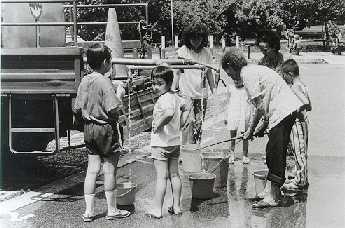
1963, a 12-hour rationing was imposed from 8 a.m. to 8 p.m.; each zone gets no water for 12 hours three times a week. When this too did not produce any significant result, an island-wide 12-hour rationing from 8 a.m. to 8 p.m. was finally introduced on 7 May 1963. The severe water rationing remained throughout the rest of 63 and was relaxed only in Jan 1964. Water rationing only completely ended on 28 Feb 64 with the return of heavy rainfall and when water stocks returned to an overall average of 75.1% in both the water catchment areas in Singapore and South Johor.
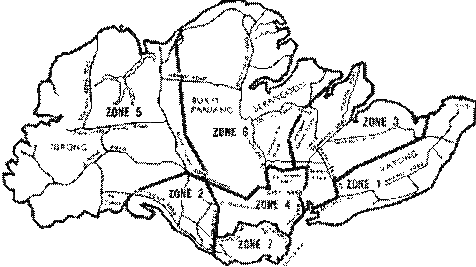
Water rationing inconvenienced many Singaporeans. They needed to be aware of the zone they were in and what the rationing hours were. To beat the rationing hours they had to wake up early or stay up late to store the water they needed. The containers they used were often also bought at inflated prices. The dry weather dried many wells in the more rural parts of Singapore, thus badly affecting the livelihood of the farmers. As consumers, Singaporeans had to pay more for the vegetables they bought. Roadside hawkers however, had very good business since more had to eat out with such long rationing hours. The water rationing also meant that PUB officers had to move round the country shutting off and turning on the valves controlling water supply.
To ensure that production at our factories did not halt and jobs not lost, the major industries were exempted from water rationing. The hospitals and bigger hotels were also able to operate without any disruption to their water supply. The public sectors were asked to determine how they could save unnecessary loss of fresh water. It was decided then that seawater, for instance, was to be used to flush the public drains.
Conclusion
A similar disruption to our water supply now could not be ruled out. Our demand for water is increasing each year. With increasing affluence, Singaporeans enjoy a good standard of living and now own many modern appliances which demand ever greater use of water. Water consumption is also increased by the setting up of more nuclear families and households.
On the other hand, Singapore is still not self sufficient despite the construction of 11 more reservoirs since 1964. The stability of our water supply from Malaysia depends very much on the state of relationship between Singapore and Malaysia, with or without the water agreements. Malaysian politicians have always brandished the threat of cutting off water whenever there is a spat between the two countries. Singaporeans have to recognize that our shortage of water is one of our key constraints. It is up to all Singaporeans to make sure that we put whatever water we have to good use and not waste a single drop unnecessarily.
|
Attachment 6.G.3.2
Worksheet 1
Name: __________________________ ( )
Class: ______________ Date: ______________

The water situation in Singapore: Demand
|
The water situation in Singapore: Supply
|
Problems faced by Singapore
|
Based on the research findings (from internet/library/books/magazines), do a brief write-up on:
Note: We have to take water conservation seriously because water shortage would have dire consequences on our economy and daily life.
Attachment 6.G.3.3
Worksheet 2
Name: __________________________ ( )
Class: ______________ Date: ______________

Based on Handout 1, give a brief write-up on the following:
Conditions that led to water rationing
|
How water rationing was carried out
|
Problems caused by water rationing
|
Note: The water rationing exercise in 1963 serves to remind us that water supply is limited but there is high demand for water.
G.4. Water in culture, traditions and religious practices
G.4.1. Overview and Background Information
- The proposed lesson of 1 hr 10 mins (2 periods) duration is on the sub-topic of Case Study of Water Supply in Singapore in the topic of Water Resources in Sec 2 Geography. It is part of the theme of Managing the Changing Environment.
- Learners would already have knowledge of uses of water, the hydrological cycle, rivers in Singapore and water demand and supply condition in Singapore.
- The proposed lesson is on the strand of water, environmentally sustainability development.
- Teachers notes: Distribute all four worksheets to all learners before the lesson. Divide the class into 4 groups and assign each group to do research on one way to increase water supply (i.e. construction of more reservoirs, recycling water, international water agreements and desalination). Learners are to bring relevant research materials and illustrations to class for the lesson. This lesson may be reinforced with a follow-up visit to the Newater Centre.
G.4.2. The Lesson Plan
Subject Matter area
|
Geography |
Time duration |
Topic |
Case Study of Water Supply in Singapore |
|
Grade Level |
8 |
|
Specific concepts covered in the lesson |
Catchment areas, vulnerability, international agreement, technology, recycling, desalination |
|
Human values addressed |
Right conduct (responsibility, resourcefulness) and non-violence (cooperation) |
|
Lesson objectives |
At the end of the lesson, learners will be able to:
- name and locate the main rivers and reservoirs in Singapore
- describe some solutions to the water shortage problem in Singapore
- appreciate international cooperation and resourcefulness in increasing water supply in Singapore
|
|
Materials needed |
- Wall map of Singapore
- Worksheet 1: Increasing Water Supply by Constructing Reservoirs
- Worksheet 2: Increasing Water Supply by Recycling Water
- Worksheet 3: Increasing Water Supply by Buying Water
- Worksheet 4: Increasing Water Supply by Desalination
- Vanguard sheets for assignment after class
|
|
Teaching-Learning Steps: |
70 mins |
Introductory or Motivational activities |
Recapitulate the water constraint in Singapore learnt from the previous lesson and then state the objectives for this lesson. Inform learners that Singapore has to actively find ways to increase its water supply. |
5 mins |
Lesson proper
|
- Ask learners to name the main rivers and reservoirs in Singapore and locate them on a wall map of Singapore. Introduce and explain the term water catchment and inform learners that about half of Singapore’s total land area is used as water catchments.
- Ask learners to get into their groups and invite those who did research on increasing water supply by increasing the catchment area like building more reservoirs to present their findings.
- Stress that there is a constraint faced in increasing the size of water catchment areas and constructing new reservoirs due to land shortage and competing land use.
- Inform learners that another way to increase water supply is to buy water from neighbouring countries. Get the next group of learners to present their research on Singapore’s water agreement with its neighbours.
- Stress to learners the importance of peaceful way of ensuring water supply through cooperation and having good bilateral relationships.
- Inform learners that Singapore is looking into high-technology methods to increase its water supply. One method is through recycling. Invite learners to share their views/experiences about using recycled water e.g. newater. Next ask the group of learners who did research on recycling water to share their findings.
- Inform learners that another high-technology method to increase water supply is desalination. Ask the next group of learners to share their research on desalination.
|
60 mins |
Closure |
- Remind learners that Singapore is not self-sufficient in water. Besides exploring high-technology methods to increase our water supply, we also have to maintain good bilateral relationships with other countries. Water is precious and it is important to manage our water supply well.
|
5 mins. |
Assessment / Evaluation |
Assignment (After class)
- Using vanguard sheets provided, each group to submit a 150-200 words write-up on their assigned method to increase water supply based on the outline provided in the worksheet. The leader in each group would divide out the tasks. Learners will do different sections of the write-up. Each group will be awarded an overall grade based on comprehensiveness and accuracy of the write-up as well as layout and illustrations.
|
|
Attachment 6.G.4.1
Worksheet 1
Name: __________________________ ( )
Class: ______________ Date: ______________


Based on the research findings (from internet/library/books/magazines), give a brief write-up on the following:
Location
|
Quantity of water supplied
|
Problems faced in constructing reservoirs
|
Note: We have to conserve water as there is a limit to increasing the size of catchment areas in Singapore.
Attachment 6.G.4.2
Worksheet 2
Name: __________________________ ( )
Class: ______________ Date: ______________

Based on the research findings (from internet/library/books/magazines), give a brief write-up on the following:
Sources of water
|
Advantages
|
Disadvantages/Problems
|
Note: It is important cooperate and maintain good relations with our neighbouring countries to ensure a steady supply of water.
Attachment 6.G.4.3
Worksheet 3
Name: __________________________ ( )
Class: ______________ Date: ______________

Based on the research findings (from internet/library/books/magazines), give a brief write-up on the following:
Advantages
|
How it is carried out
|
Problems faced
|
Note: We have to be resourceful and enterprising in using technology to ensure a diversified and sustainable water supply.
Attachment 6.G.4.4
Worksheet 4
Name: __________________________ ( )
Class: ______________ Date: ______________

Based on the research findings (from internet/library/books/magazines), give a brief write-up on the following:
Process
|
Advantages
|
Disadvantages/Problems
|
Note: We have to be resourceful and enterprising in using technology to ensure a diversified and sustainable water supply.
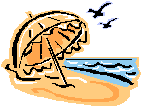
|














 2
2








